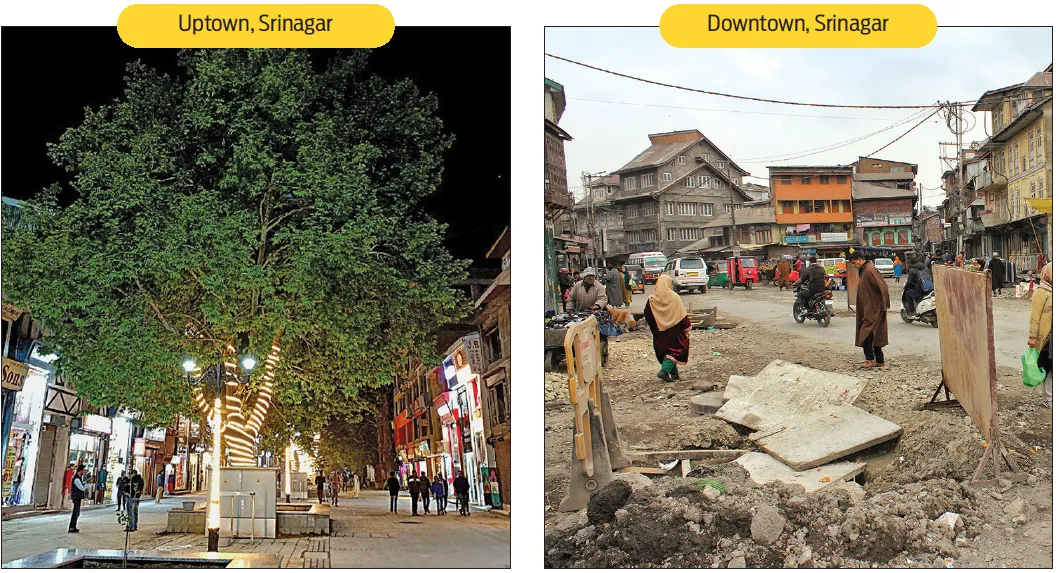Had famous English novelist and social critic Charles Dickens been alive, he would have set his famous novel A Tale of Two Cities in Srinagar’s Uptown and Downtown areas instead of London and Paris!
Spread over 246 sq.km, Srinagar is the largest populated city in J&K with a population of 1.50 million people. The city is the hub of tourism and trade activities.
In Srinagar’s Uptown areas, people feel as if they are in a developed city with revamped public places, streets, footpaths, smooth roads and life-size LED screens. While moving through
Downtown seems like being in a gloomy underdeveloped place—most of the roads in Downtown, popularly known as Shaher-e-Khaas, are dotted with potholes. At some places, roads have been haphazardly filled up after laying a network of drainage pipes. Uncovered manholes across the Old City pose serious risk to commuters.
While works under the ambitious Srinagar Smart City project were completed on a war-footing in Uptown areas, similar projects are being executed at a snail’s pace in Downtown areas.
Inhabitants of Downtown have been voicing their concerns over what they term as haphazard construction of footpaths in congested roads. Notwithstanding the criticism, even footpaths have been widened on narrow roads in Old City leaving less space for smooth vehicular movement.
Ironically, these extended footpaths are not being used by pedestrians. In absence of regulation, these newly constructed and widened footpaths have been encroached upon by shopkeepers and vendors. In this scenario, pedestrians have to bear the brunt and walk on narrow roads braving risk of accidents.
The condition of the roads in Downtown is so bad that even the hi-tech e-buses frequently get stuck in uneven surfaces. That is why planning is must before execution of a project. Authorities in Srinagar seem to have been inspired by the design of footpaths and roads in foreign countries, but they forgot Srinagar’s historic character, people and unique climatic conditions. Suggestions of common people must be considered and included in policies and plans meant for them.
While there are multiple parking places in the city centre Lal Chowk area, Downtown doesn’t have a dedicated single parking bay. People in Old City park their vehicles on roads, lanes and by-lanes at their sweet will— triggering traffic jams. At several places, hi-tension poles are standing in the middle of roads in Downtown areas, even years after road widening.
As the Uptown areas shine at night amid hi-tech lighting systems, roads in Downtown reel under darkness in absence of even street-lights. Downtown is teeming with a growing population of stray dogs mainly due to the presence of open garbage dumps.
There are hundreds of overflowing drains giving ugly look to the historic city. Even historical places in Downtown are in ruins in absence of maintenance. Encroachments around several historical places have been left untouched. Earlier this month, a part of a Mughal-era heritage wall, also called Kalai, collapsed at Bachi Darwaza locality in absence of repairs.
Several roads widening in Downtown are gathering dust from the past several decades. Downtown’s three main routes- Khanyar-Zadibal-Pandach road, Syed Meerak Shah road (SMS) and Circular Road Project that were identified decades ago for urgent widening to develop the future flow of traffic, are facing inordinate delay in completion.
These road projects are considered to be crucial for catering to growing traffic flow in Downtown. Inordinate delay in completion of these projects has led to cost escalation for land acquisition and compensation for structures.
Srinagar’s lone garbage dumping site is situated at the Achan area of Downtown. Constructed in 1989, the dumping site caters to 550 metric tons of garbage on an average in a day. Till now around 12 lakh metric tons of waste has accumulated in the dump. In summer, a pungent smell from the dumping site engulfs whole Downtown areas turning into health hazards for residents.
Unscientific garbage disposal is slowly but steadily causing contamination of soil and ground water resources by leachate outflow.
In 2017, the Government had proposed to set-up a waste-to-energy plant at Achan area on Srinagar outskirts. The National Green Tribunal (NGT) had fixed an 18-month timeframe to establish the facility but despite the passing of nearly six years, the project is yet to take off.
Most of the water bodies in Downtown including Aanchar, Gilsar and Khushalsar have been marred by extensive pollution and encroachments in absence of sustained conservation measures by authorities. Nallah Mar, a canal which snaked through the Downtown, was buried alive over four decades ago.
More than beautification measures, authorities must ensure proper planning and execution of projects. There has to be equitable development across Srinagar in harmony with our environment and culture.
There is a need to preserve Downtown’s traditional architecture and promote its traditional food, arts and crafts. A large number of tourists, especially foreigners, have been regularly visiting Downtown. This old part of the city can be developed as a heritage destination of Srinagar.
We have to understand that Downtown is a repository of our glorious history and rich cultural ethos. Shaher-e-Khaas is the soul of Srinagar. It is high time for authorities and people to join hands and restore the glory of Downtown.
Author is Executive Editor, Greater Kashmir







